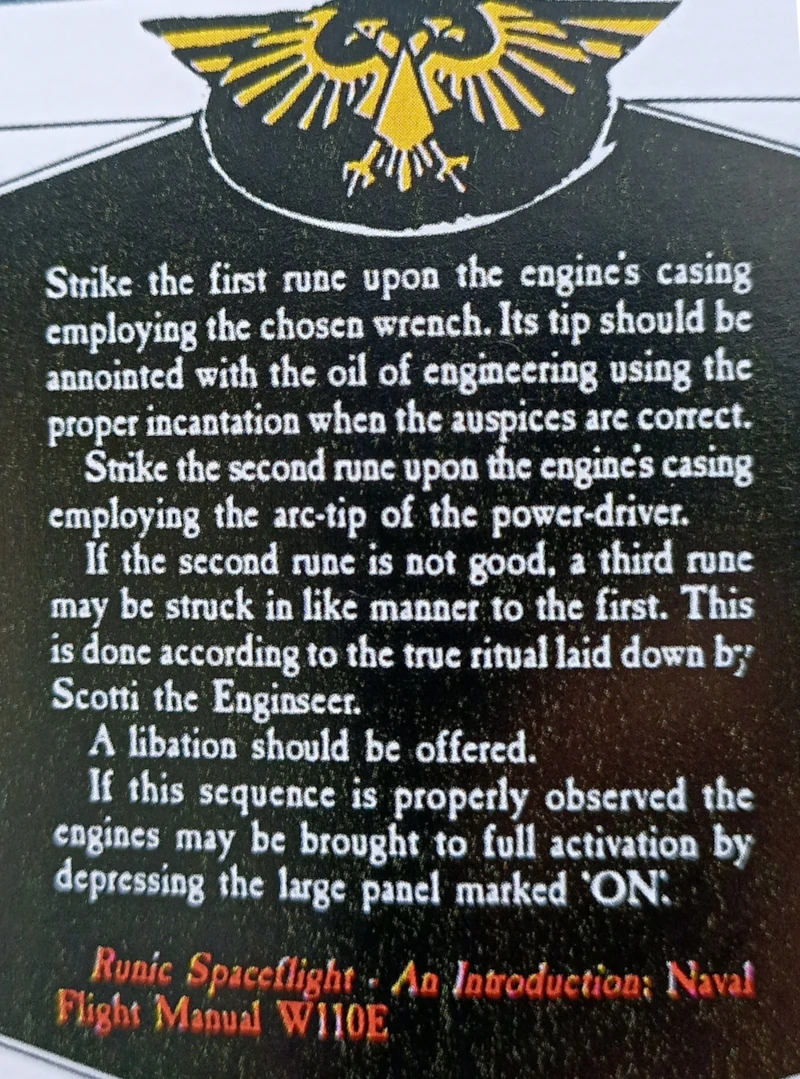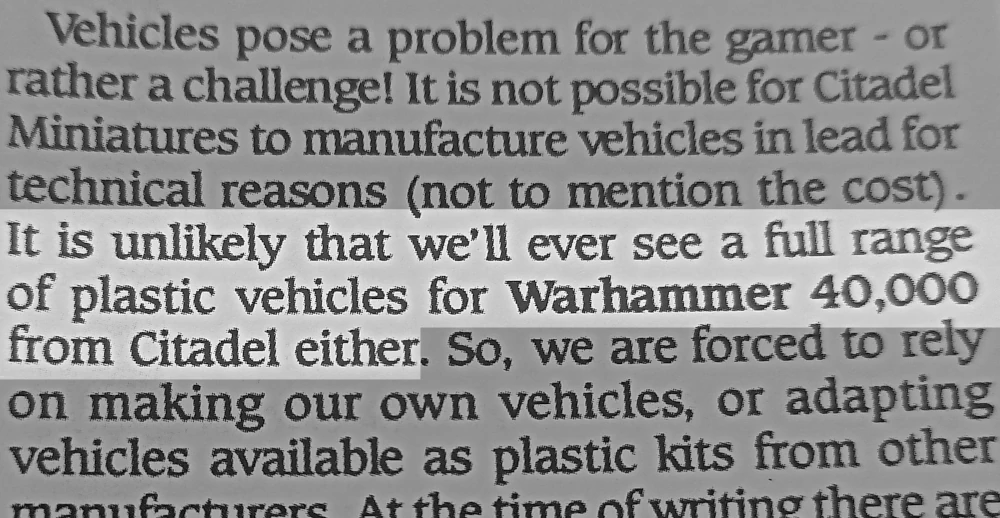Games Workshop re-released the first edition (titled Rogue Trader) of Warhammer 40,000 to celebrate the game's 30th anniversary. I bought a copy to taste the nostalgia that, as someone who started out in 40k in the 2000s, I never got to experience. I'm reviewing it chapter by chapter, and this post covers Chapter 2: Equipment.
All of the weapons of Warhammer
Since I got into playing Warhammer 40,000, I've been looking desperately for an armoury source book. In the roleplaying world, an armoury chapter or book is all but a requirement, if not for a core rulebook then certainly for a splat book (but more often than not, both). Over the years, a traditional format has developed for an armoury: name of weapon, description, game stats, graphic. It's how a substantial number of D&D nerds know a halberd from an axe, or a cuirass from a greave, or a dragon orb from a scrying glass. It seemed odd to me that Warhammer 40,000 game books barely mention weapon types, especially when there are physical toy soldiers bearing weapons that affect how the game works.
It seems like it would be easy money for Games Workshop to throw some illustrations of weapons, along with a description of what each weapon does, into a book and charge $100 for it.
Maybe Games Workshop hasn't thought to publish such a book because they think they've sufficiently explained its universe's weapons, because Rogue Trader has a whole chapter about nearly every weapon you can imagine in the 41st millennium. I'm not exaggerating when I say that this chapter, from the very first edition of Warhammer 40,000, makes this book worth every penny. In fact, it makes the book a bargain because I'd buy just this chapter for $100. This is exactly the source book I was looking for (barring some modern Mechanicus weapons that hadn't been imagined up yet).
Obviously the stats for the weapons aren't relevant any more, but the descriptions are valid and the graphics explain everything about your Citadel toy soldiers. Not sure how to tell a Plasma gun from a melta? Not sure what a web gun is? Confused about lasguns and stubbers? This chapter answers all of your questions, with helpful illustrations.
I can't emphasize it enough. If you're new to gaming in the 40k universe and are looking for information about guns, ammo, armour, vehicles, and general equipment, then this is the chapter you've been hoping for.
Humour
Warhammer 40,000 is heavily based on absurdist satire, but sometimes it gets really silly. The cult Mechanicum is one of my favourite absurdist factions. There are several snippets of ridiculous Imperial propaganda throughout Rogue Trader. One block of such text is an excerpt from a fictional tech manual, which conveys perfectly how the Adeptus Mechanicus is supposed to work. If the person who taught you how to operate a machine happened to scratch his head during the demonstration, then you scratch your head at the same moment every time you operate the machine. There's also a healthy dose of Han Solo logic, with banging on panels is the ultimate answer to jumpstarting a system. But as an extra treat, the text mentions "the engineer Scotti", which is a pretty obvious reference to Scotty from Star Trek, which I can appreciate as a recovering Trekkie (to be precise, I was a Trekker).

Vehicles
When Rogue Trader was written, Citadel didn't produce vehicles. Not only that, but they could foresee no time when they'd be able to produce vehicles.

At the time, miniatures were made of lead, so a vehicle model would end up being very heavy. The advice given in the book is to make your own vehicles, or else to use model vehicles intended for other purposes. I think the obvious example of this are tanks, and the book cleverly establishes that tanks in the 41st millennium look, conveniently, a lot like the tanks of the [real life] World Wars. You can buy a model tank off the shelf, add some 40k guns to it (and now you know which guns to add!), and you have a vehicle for your game!
This was, to my surprise, my other favourite part of the chapter. People have called it "charming" that early 40k material encouraged players to make their own terrain and vehicles, but to me it's just pragmatic. Today, Games Workshop sells its fair share of purpose-built terrain and vehicles, and obviously they want people to buy those kits. I don't know that it's necessarily their job to tell players that imagination is a powerful creative tool, but I've got a White Dwarf from last year (2023) that has a hobby section demonstrating how to make a fortress out of junk, and an issue from this year demonstrating how to build a vertical Necromunda battlefield. so the pragmatism still exists, and it's still acknowledged. Realistically, the more you imagine new scenarios, the less any single company can provide you with exactly the physical structures you envision on your battlefield.
More than pragmastism, though, I appreciate that vehicles are defined generically, and have stat blocks you generate yourself. Without a miniatures line for vehicles, Games Workshop couldn't provide stats for a specific thing. The author instead provides modular components and empty stat blocks that you fill in based on die rolls. This has its advantages and disadvantages, of course. I admit that it's really nice to have stats for a miniature. You buy the rulebook, you buy a codex or army book, you buy your box of miniatures, and you're ready to play the game. I don't appreciate that the game stats for miniatures are sold separately, but in the end you don't have to spend time devising stats for your 60-soldier army. (Then again, a 60-soldier army is rarely actually 60 unique soldiers. Many of your soldiers are uniform, with the same armour and weapons as the next soldier. Still, minor differences do add up.)
But I also appreciate modular design, and players with the recipe for creating miniature profiles can get really creative. Some of my favourite matches have been the ones where I used custom profiles for miniatures that were never intended for the game. So I love that Rogue Trader provides a system for creating your own vehicle profiles. It encourages creativity and experimentation, and I wish modern 40k (and Middle-earth Strategy Battle Game, for that matter, although I took care of that myself) provided the same easy flexibility.
Games master
It's in this chapter, I think, that the intended role of the Games Master (GM) becomes clear, although it's still not as explicit as I think it needed to be. Reading between the lines, though, it seems the GM has five jobs:
- Devise the scenario, with objectives and complications
- Devise secret effects (like minefields, irradiated zones, and so on)
- Maintain lasting effects (like gas clouds, radiation, smoke, and anything that lingers on the battlefield even after the turn when it was detonated)
- Run any monster or army that's not part of a player army
- Know the rules and handle edge cases
That's enough to keep a GM busy, I think, but there's a defnite lack of separation between player rules and GM rules. It's not clear how much about the game a player needs to know, and how much the GM is expected to handle. I can imagine a GM showing up to a game with experienced players and feeling surplus to requirements, but I can also imagine a GM doing so much that the game is impenetrable to a new player. I guess maybe the idea was that the GM was the "stack", a supervisor who could remember a game mechanic that persisted over several rounds so players could focus on just the army. That does seem like a useful thing to have, but the rules are so finely crafted that the game really does lend itself to being controlled just by the players. In the end, the role of the GM could largely be managed by tokens or tighter rules, random tables, and 10 pages of scenario ideas. I assume that's the reason the role of the GM didn't really catch on for Warhammer.
I don't think it's a loss that the role of the GM was removed, but it is an interesting artefact of the game, and maybe a hint at its original intent. With or without the GM as a listed game role, I think it could be fun to either play with a GM or play as a GM some time.
The best source of Warhammer 40,000 equipment
Like the rest of this book so far, chapter 2 was a pleasant surprise for me. I didn't expect the book to feel like a modern game, much less for it to actually be useful. Far from a relic of gaming history, chapter 2 of Rogue Trader is a resource I've already actually used while painting miniatures and building army lists. I'd been looking for a source book about 40k weaponry for months, and haven't been able to find one. I even checked in the Warhammer+ vault. I never expected the answer to be the re-release of the first edition of the game, but I'm happy to have found it.
Next up is the presumably lore-heavy Chapter 3: The Age of the Imperium.
Header photo of book, glasses, and dice is licensed Creative Commons cc0.